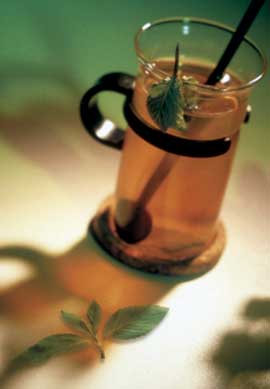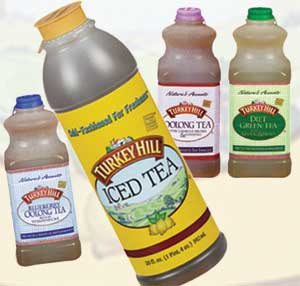

Indeed, through the centuries, many have found that they agreed with the emperor’s assessment of tea. In fact tea is second only to water in worldwide consumption. It is consumed in a variety of forms: Hot, iced, spiced and flavored, as well as with or without sugar, honey, milk, cream or lemon. In the United States, more than three-fourths of all tea consumed is in the iced form, which just so happened to be invented by chance in 1904 at the Louisiana State Purchase Exposition in St. Louis, Mo. Accordingly, one day of the fair, the temperature was soaring and the staff in the Far East Tea House couldn’t get fair-goers to sample their hot tea. So, they got inventive and poured it over ice cubes. The drink quickly became the exposition’s most popular beverage.
Interestingly, there are around 3,000 varieties of tea, but they all come from that same evergreen plant—C. sinensis—identified by Shen-Nung. These many varieties of tea are classified by the manner in which the leaves are processed after plucking.
The most common form of tea in North America, to date, is black tea, which refers to freshly plucked leaves that are withered indoors on open-air shelves without any physical breaking of the leaf structure. After withering, the leaves are rolled, exposing the enzymes in the leaf to the atmosphere, allowing them to ferment. At a critical point, the fermenting tea leaves are fired at high heat to stop the fermentation process.
Green tea, which is projected by tea industry analysts to outsell black tea in the States by 2008, refers to plucked leaves that are not fermented. Rather, the leaves are steamed or otherwise heated immediately after plucking to prevent the fermentation that makes black tea. Then the leaves are rolled and dried.
Oolong tea is fermented only partially, to a point between black and green teas. While the leaves wilt naturally, enzymes begin to ferment them. Processors interrupt the fermentation by stirring the leaves in heated pans, then rolling and drying them.
Flavored and spiced teas are typically made from black tea. Flavors are usually sprayed on, whereas spices are included as bits and pieces. Herbal teas are not real tea, as they are not derived from the C. sinensis plant. Within the tea industry, herbal teas are classified at tisanes.

“Fruits, vegetables and tea all contain important antioxidants. Research suggests these phytonutrients may contribute substantially to the promotion of health and the prevention of chronic disease. For example, recent research studies reveal the antioxidants in tea may inhibit the growth of cancer cells and support cardiovascular health,” according to Jeffrey Blumberg, chief of the antioxidants research laboratory at the Jean Mayer USDA Human Nutrition Research Center on Aging at Tufts University, Boston.
This includes a new category of tea referred to as white tea. Like green tea, white tea is unfermented. White tea leaves are allowed to dry completely in the sun without any pan frying or steaming, resulting in a purer, natural state. During plucking, great care is given to the selection of leaves. Usually only the youngest leaves, which are still covered with down (short white hair), are used. The absence of withering, rolling and oxidation keeps the appearance of the leaves intact, and because the silvery down is still visible, leaves look white in color.
According to scientists at the University of Scranton in Pennsylvania, a specific brand of white tea solids was “off-the-charts” in terms of polyphenol content. Chemistry Professor Joe Vinson says, “[This brand of] white tea is almost twice as high as the average black tea.”
It is the polyphenols in tea that are responsible for antioxidant activity. In fact, the pure catechins and phenolic acids found in tea were found to be more powerful than the antioxidant group of vitamins C, E and ?-carotene in an in vitro lipoprotein oxidation model.
Milk has its inherent nutritional and functional benefits, and so does tea, which further supports why tea is an ideal addition to a dairy’s beverage line-up.

Tea's role with dairies
Right alongside milk, water, juices and fruit drinks, dairies have been offering iced tea beverages as part of their product line up since the 1960s.“When we first approached dairies about manufacturing, packing and distributing iced tea, it was considered a very novel idea, and there were few players in the field,” says Edward Reeves, president and founder of one of the country’s founding tea ingredient suppliers to the dairy industry. “Today it is a big part of many of their businesses. And it makes sense. Dairies already have made the investment in filling and packaging equipment for milk; they have the knowledge of microbiological requirements; and they have the ability to deliver refrigerated products.”
Joe Allen, president of a flavor house that specializes in iced tea pre-mixes remembers hearing of a Pennsylvania dairy that actually attempted to brew iced tea using a bed sheet and real tea leaves. Even though the approach did not work, the dairy was determined to make tea. “Instant tea became available and it became possible for dairies to get involved in this highly profitable product line,” he says.
Indeed, instant tea is what made it all possible.
“Many years were spent with my research and development colleagues trying to perfect the process of instantizing tea,” adds Reeves. “When we finally accomplished the process in the 60s, we were able to greatly improve a dairy’s ease of manufacturing iced tea.”
Allen adds, “Since then, tea has become a big business for almost all the dairies in Pennsylvania, as there’s just something about tea that Pennsylvanians love. But getting other dairies around the country interested has been challenging.”
Tom Wright, v.p. of technical services and procurement at Turkey Hill Dairy, Conestoga, Pa., says, “It helps when butterfat and milk costs go through the ceiling, that we can balance our cost through tea manufacturing. As its sales widen and increase, particularly during the summer months when cream and butter costs are usually the highest, it’s nice to have the tea business to counteract the rising cost of making and selling ice cream. We’re happy to see that a product that has become a Lancaster County [Pennsylvania] food staple over the years is starting to develop the same cult following in our other market areas.”
Indeed, not only is iced tea a profitable business for dairies, there are practically no start-up costs.
“To add a beverage like tea to a dairy’s product line costs practically nothing,” Allen continues.
Suppliers will work with dairies to perfect the manufacturing process. They can even assist with creating a signature flavor profile.
“The other thing about iced tea is that there are many regional flavor preferences. Some parts of the country like their tea sweeter than others. There are also variations in brew strength and tea pucker,” Allen adds. “Because dairies typically cater to regions, it is a perfect fit. They have the upper hand over a nationally branded shelf-stable product.”
Another advantage that pasteurized iced teas have over cold-filled teas is they don’t require preservatives. “And preservatives are what so often cause that undesirable back-of-the-throat burn you get with some non-refrigerated iced teas,” says Susan Brady, a sales manager with a tea ingredient company.
Reeves adds, “With bottled and canned tea, it is inevitable that there will be a mild loss of tea flavor, as the preserving and heating requirements for these processes are much less forgiving than dairy pasteurization.”
“Which is exactly why iced tea is a perfect fit for dairies,” concludes Brady.
Tea ingredient options
Most dairies use a soluble or instant tea pre-mix that contains the tea and any added flavors such as lemon, peach, orange or raspberry. Dairies simply measure off how much mix they need, add sweetener and process like fluid milk. In low-calorie or diet formulations, the high-intensity sweetener is part of the pre-mix. The advantage to using a dry mix is that once the mix is open, its shelflife is longer than syrup, which has to be used up fairly quickly to prevent spoilage and contamination. Dry mixes also tend to be easier to measure than syrups, ensuring a more consistent product.“What’s really generating interest in ready-to-drink iced tea is green tea,” adds Allen. “Consumers are looking for healthful alternative beverages and iced green tea is it. We can make it even more value added by including vitamins, minerals or nutraceutical ingredients in the pre-mix.
“Any dairy planning on getting involved in iced teaand all of them should be thinking about it because it is such a profitable product lineshould really plan on marketing a green tea, in addition to a regular brew, with and without lemon," Allen says.
Brady agrees, and adds, “There’s also interest in making iced white tea, as it is very light in appearance and flavor, which means it requires little sweetener and consumers perceive it as a refreshing, light, good-for-you drink. And they’re right!”
But there’s even a more novel opportunity for dairies. It’s chai. This tea beverage truly is a fit for dairies, as the formulation requires the addition of milk.
Chai is a centuries-old Asian beverage that is typically served hot, but since being modernized, is frequently consumed cold, particularly in the United States. It is a blend of milk, fine black teas, honey and a variety of spices, which vary by region and culture. Typically, cardamom, ginger and even pepper are used as spices.
“The chai category is growing at almost 100% per year,” says Bill McSpadden, dir. of operations, Pacific Beverage, Midlothian, Va. “Consumers are embracing it as an alternative to coffee and tea. Most consider chai to be a hybrid cross between coffee and tea…containing the rich creaminess of coffee but with the health benefits of drinking tea.
“We think that the dairy portion is key in adding body and creaminess while dulling the sometimes bitter notes that tea often brings,” McSpadden adds. “The tea adds earthy natural tones to round out the dairy taste. We frequently get requests for a non-dairy product but we have opted not to do that because the taste profile without the nonfat milk powder ends up being flat and artificial tasting.”
Pacific Beverage markets Pacific Chai latte mix, which was the first powdered chai available in the retail market. It comes in multi-serving containers, as well as single-serve packets. Flavors are Spice, Vanilla and Vanilla Decaf. The Pacific Chai product line had been awarded five gold medals including two Best of Show Gold Medals from the American Tasting Institute.
“We have always been the leader in managing our flavor profile. We created a product that the consumer did not know that they wanted but once they tried it, it became a part of their daily drinking routine,” says McSpadden. “In fact, many people say that Pacific Chai is finally an alternative to coffee for people who don’t like coffee.
Pacific Chai’s success has obviously caught the eye of traditional tea marketers. New under the Lipton brand is a similar retail product called ChaiLatta Chai Tea Latte Mix. Also made with dairy ingredients, ChaiLatta comes in four varieties: Chocolate, Hazelnut, Original and Vanilla.
“We are hoping to see dairies pick up on the chai trend and offer it as a ready-to-drink item,” says Brady. “Suppliers blend the tea and spices together in a soluble dry mix without any stabilizers. So unlike chocolate and other milk flavorings that require stabilizers to keep particles in suspension, chai mix is completely soluble.
“Dairies have earned the right to market themselves as suppliers of premium, freshly-made teas,” Brady says. “This quality-based approach will protect their place as successful beverage players.”
Tea, a natural complement to dairy.
